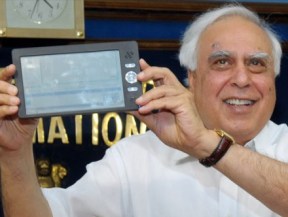Update: Datawind confirms that the “pre-orders” are no-money-down reservations, not paid-in-full pre-orders. So it’s more like people waiting in line than real orders. The Aakash is sold out but more will be manufactured, and the reservations are in part for the Ubislate. Regardless, demand seems to be high for the low-cost device and its slightly-higher-cost successor, more than enough to justify the increase in capacity.
The low-cost Indian tablet known as the Aakash, which we have followed in its career over the last year, is finally shipping. In late December they opened up orders for the first batch of 30,000 units, and brought so much traffic to their retail site that an Indian cyber regulation agency called to inform them they were possibly under attack. And in the last two weeks, they’ve racked up over 1.4 million pre-orders — iPad-scale numbers.
It’s being sold for Rs2500, which translates to just under $50. The government then subsidizes sales to students, bringing the cost down to $35. But while the government originally suggested a million devices would be on the ground before the end of 2011, the Indian manufacturer won’t be pushing out devices at a decent rate until this coming April, and at that point the Aakash may find itself an orphan device.
Despite the original bluster from the Indian government, which fanned the flames of sensationalism with increasingly absurd price estimates (at one point they were talking about a $10 device), the device has passed trials that have killed many a device, and is in fact finalized, in manufacture, and shipping. But India does not have enough manufacturing capacity to supply the hundreds of thousands of orders that are rolling in. New factories being built by Datawind in Cochin, Noida, and Hyderabad will solve that problem, but in the meantime the Aakash is under attack from other directions.
Datawind, which manufactures the device, has begun to push an alternative to the Aakash: a slightly more expensive device with better specs called the UbiSlate 7+. At Rs2999, it offers a much better processor (700MHz Arm Cortex A8 vs the Aakash’s 366Mhz Arm11), a bigger battery, a newer version of Android, and mobile data (on GPRS). It’s not unthinkable that this device might be embraced by the many institutions that have been waiting patiently for the promised flood of cheap, standardized tablets.
The delays on the government’s part may end up making the Aakash an obsolete device that isn’t even much cheaper than the competition. And Problems with the hardware and software, while haven’t stopped the device from pulling in tons of pre-orders, suggest that even after all this time it is still being rushed to market. The tech market is merciless, and even the pro-Aakash contingent may find itself rooting for something more practical after a few months.
India’a Aakash experiment has been a long and strange one, and may yet prove to be a success or failure. Either result would be limited, however: a success would be minor as they must still struggle to justify and produce the device in the face of increasing competition, and failure would mean mainly that they would have to scrap the current model and try again fresh for a 2012 launch.
And either result is respectable, because the entire idea is respectable, and the rocky road upon which it has traveled was more or less expected. It’s the entrepreneurial spirit moving within the government, and has its roots in a desire to better their population’s lot and to try something new. And at any rate what’s more interesting than the device itself is the continuing investment in an infrastructure in which a national tablet is developed, manufactured, and nurtured.
TechCrunch has many readers in India, and their comments on the topic (being closer to the matter) will be appreciated.
